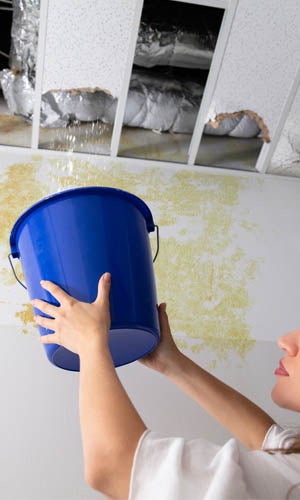Guide To Water Leak Discovery At Home
Guide To Water Leak Discovery At Home
Blog Article
The article author is making a few good pointers about Locating water leaks overall in the article beneath.

Early discovery of dripping water lines can mitigate a possible disaster. Some tiny water leaks may not be visible.
1. Take A Look At the Water Meter
Every residence has a water meter. Examining it is a surefire way that helps you find leaks. For starters, turn off all the water sources. Ensure nobody will flush, utilize the faucet, shower, run the washing device or dishwashing machine. From there, go to the meter as well as watch if it will change. Since no one is using it, there should be no movements. If it moves, that shows a fast-moving leakage. If you discover no adjustments, wait an hour or 2 as well as examine back again. This means you might have a slow-moving leakage that could also be below ground.
2. Examine Water Usage
If you identify sudden adjustments, despite your intake being the same, it suggests that you have leaks in your plumbing system. An abrupt spike in your expense shows a fast-moving leak.
A consistent increase every month, even with the very same behaviors, shows you have a sluggish leakage that's also gradually rising. Call a plumber to thoroughly inspect your home, specifically if you feel a warm location on your flooring with piping beneath.
3. Do a Food Coloring Test
30% comes from toilets when it comes to water intake. Examination to see if they are running properly. Decrease flecks of food shade in the container and wait 10 minutes. There's a leakage in between the tank and also dish if the shade somehow infiltrates your bowl during that time without flushing.
4. Asses Outside Lines
Do not fail to remember to check your exterior water lines too. Needs to water permeate out of the link, you have a loosened rubber gasket. One small leakage can throw away heaps of water and also increase your water expense.
5. Examine the situation and examine
Home owners must make it a habit to inspect under the sink counters and also also inside cabinets for any type of bad odor or mold and mildew development. These two warnings suggest a leakage so timely interest is required. Doing routine evaluations, even bi-annually, can conserve you from a major trouble.
Check for discolorations as well as damaging as the majority of home appliances and also pipelines have a life expectancy. If you think leaking water lines in your plumbing system, do not wait for it to rise.
Early discovery of dripping water lines can mitigate a potential calamity. Some tiny water leaks may not be visible. Checking it is a guaranteed method that assists you uncover leakages. One little leakage can throw away tons of water and increase your water costs.
If you believe dripping water lines in your plumbing system, do not wait for it to rise.
5 Signs that Your Home Has a Hidden Leak
Your water bill is unusually high without explanation
Generally, your water bill tends to stay consistent throughout the year as long as the same number of people live in your household year round. The bill might be higher during certain times of the year, such as summer, when your lawn may require more watering than it does in cooler months. However, if you notice a rise in your water bill that you can’t explain, it’s an indicator that there’s a hidden leak somewhere in your home.
You hear running water
One of the biggest signs that you have a water leak is the sound of rushing water when no plumbing fixtures are on and when no water-using appliances are running. If you hear running water in your walls when no water is being used anywhere in your home, locate your home’s main water shut-off valve, shut off your water supply, and contact a plumber at once.
Your home smells musty
Hidden leaks often occur in dark spaces, such as behind walls or under carpeting. Incidentally, darkness and moisture can create an ideal breeding environment for mold or mildew. If you start to smell mildew or the scent of rotting wood or stagnant water around your home, it’s a fair bet that a leak is the culprit.
You find wet spots around your home
The wet spots usually show up as moist areas in your carpeting. If your home has a basement level, puddles on the floor could indicate a slab leak. Outside, unexplainable puddles or lush, green patches in your yard often mean that there’s a leak in your sewer line or main water line.
You have stains, bubbles, or condensation on your walls/ceiling
Stains or condensation on your walls or ceiling are both major signs of a hidden leak. Also, drywall (AKA. sheetrock) is very absorbent, and as it takes on more water from a leak behind a wall, it will start to bubble, swell, or warp. If you see this happening in your home, don’t wait to contact a plumber before the water damage spreads.
https://www.ezflowplumbingaz.com/blog/2019/june/5-signs-that-your-home-has-a-hidden-leak/

I'm certainly very curious about Detecting hidden plumbing leaks and I really hope you liked our entry. Do you know anybody else who is serious about Hacks to detect leaks? Do not hesitate to promote it. Kudos for your time. Visit us again soon.
Report this page